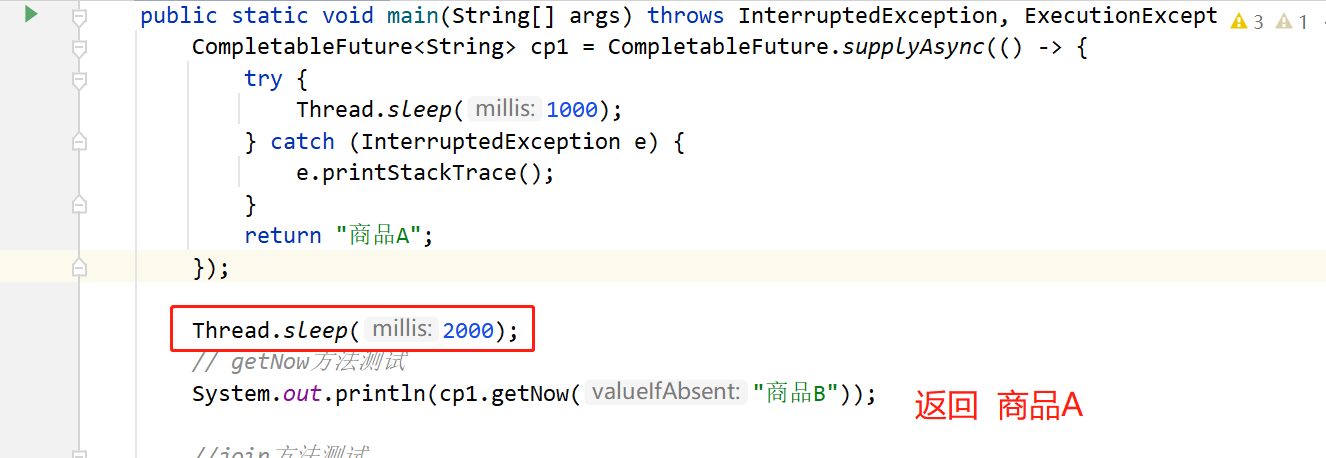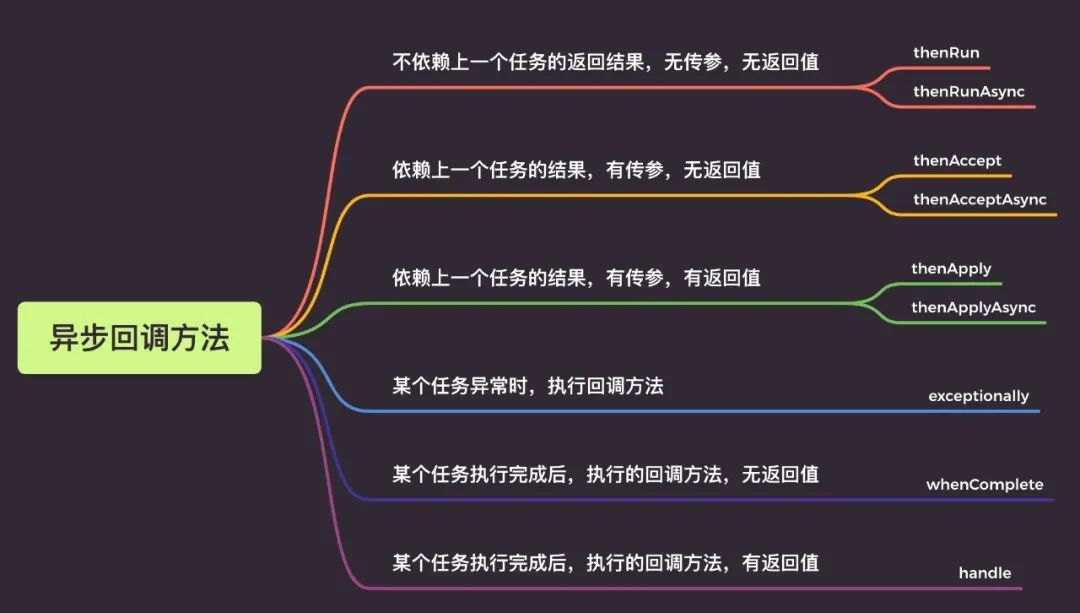import java.util.concurrent.CompletableFuture; import java.util.concurrent.ExecutionException; public static void main(String[] args) throws InterruptedException, ExecutionException { long startTime = System.currentTimeMillis(); //调用用户服务获取用户基本信息 CompletableFuture<String> userFuture = CompletableFuture.supplyAsync(() -> { try { //模拟查询商品耗时500毫秒 Thread.sleep(600); } catch (InterruptedException e) { e.printStackTrace(); } return "用户A"; }); //调用商品服务获取商品基本信息 CompletableFuture<String> goodsFuture = CompletableFuture.supplyAsync(() -> //模拟查询商品耗时500毫秒 { try { Thread.sleep(400); } catch (InterruptedException e) { e.printStackTrace(); } return "商品A"; }); System.out.println("获取用户信息:" + userFuture.get()); System.out.println("获取商品信息:" + goodsFuture.get()); //模拟主程序耗时时间 Thread.sleep(600); System.out.println("总共用时" + (System.currentTimeMillis() - startTime) + "ms"); }
运行结果

CompletableFuture创建方式
1、常用的4种创建方式
CompletableFuture源码中有四个静态方法用来执行异步任务
public static <U> CompletableFuture<U> supplyAsync(Supplier<U> supplier){..} public static <U> CompletableFuture<U> supplyAsync(Supplier<U> supplier,Executor executor){..} public static CompletableFuture<Void> runAsync(Runnable runnable){..} public static CompletableFuture<Void> runAsync(Runnable runnable,Executor executor){..}
-
「supplyAsync」执行任务,支持返回值。
-
「runAsync」执行任务,没有返回值。
「supplyAsync方法」
//使用默认内置线程池ForkJoinPool.commonPool(),根据supplier构建执行任务 public static <U> CompletableFuture<U> supplyAsync(Supplier<U> supplier) //自定义线程,根据supplier构建执行任务 public static <U> CompletableFuture<U> supplyAsync(Supplier<U> supplier, Executor executor)
「runAsync方法」
//使用默认内置线程池ForkJoinPool.commonPool(),根据runnable构建执行任务 public static CompletableFuture<Void> runAsync(Runnable runnable) //自定义线程,根据runnable构建执行任务 public static CompletableFuture<Void> runAsync(Runnable runnable, Executor executor)
2、结果获取的4种方式
对于结果的获取CompltableFuture类提供了四种方式
//方式一 public T get() //方式二 public T get(long timeout, TimeUnit unit) //方式三 public T getNow(T valueIfAbsent) //方式四 public T join()
说明:
-
「get()和get(long timeout, TimeUnit unit)」 => 在Future中就已经提供了,后者提供超时处理,如果在指定时间内未获取结果将抛出超时异常
-
「getNow」 => 立即获取结果不阻塞,结果计算已完成将返回结果或计算过程中的异常,如果未计算完成将返回设定的valueIfAbsent值
-
「join」 => 方法里不会抛出异常
public void testCompletableGet() throws InterruptedException, ExecutionException { CompletableFuture<String> cp1 = CompletableFuture.supplyAsync(() -> { try { Thread.sleep(1000); } catch (InterruptedException e) { e.printStackTrace(); } return "商品A"; }); // getNow方法测试,如果未计算完,则返回设定的默认值valueIfAbsent System.out.println(cp1.getNow("商品B")); //join方法测试 CompletableFuture<Integer> cp2 = CompletableFuture.supplyAsync((() -> 1 / 0)); //不会抛出异常 System.out.println(cp2.join()); //抛出异常 System.out.println("-----------------------------------------------------"); //get方法测试 CompletableFuture<Integer> cp3 = CompletableFuture.supplyAsync((() -> 1 / 0)); System.out.println(cp3.get()); }
「运行结果」:
-
第一个执行结果为 「商品B」,因为要先睡上1秒结果不能立即获取
-
join方法获取结果方法里不会抛异常,但是执行结果会抛异常,抛出的异常为
CompletionException -
get方法获取结果方法里将抛出异常,执行结果抛出的异常为
ExecutionException

异步回调方法

示例
public void testCompletableThenRunAsync() throws InterruptedException, ExecutionException { long startTime = System.currentTimeMillis(); CompletableFuture<Void> cp1 = CompletableFuture.runAsync(() -> { try { //执行任务A Thread.sleep(600); } catch (InterruptedException e) { e.printStackTrace(); } }); CompletableFuture<Void> cp2 = cp1.thenRun(() -> { try { //执行任务B Thread.sleep(400); } catch (InterruptedException e) { e.printStackTrace(); } }); // get方法测试 System.out.println(cp2.get()); //模拟主程序耗时时间 Thread.sleep(600); System.out.println("总共用时" + (System.currentTimeMillis() - startTime) + "ms"); } //运行结果 /** * null * 总共用时1610ms */
「thenRun 和thenRunAsync有什么区别呢?」
如果你执行第一个任务的时候,传入了一个自定义线程池:
-
调用thenRun方法执行第二个任务时,则第二个任务和第一个任务是共用同一个线程池。
-
调用
thenRunAsync执行第二个任务时,则第一个任务使用的是你自己传入的线程池,第二个任务使用的是ForkJoin线程池。
说明: 后面介绍的thenAccept和thenAcceptAsync,thenApply和thenApplyAsync等,它们之间的区别也是这个。
2、thenAccept/thenAcceptAsync
public void testCompletableThenAccept() throws ExecutionException, InterruptedException { long startTime = System.currentTimeMillis(); CompletableFuture<String> cp1 = CompletableFuture.supplyAsync(() -> { return "dev"; }); CompletableFuture<Void> cp2 = cp1.thenAccept((a) -> { System.out.println("上一个任务的返回结果为: " + a); //dev }); cp2.get(); //返回null }
3、 thenApply/thenApplyAsync
表示第一个任务执行完成后,执行第二个回调方法任务,会将该任务的执行结果,作为入参,传递到回调方法中,并且回调方法是有返回值的。
示例
public void testCompletableThenApply() throws ExecutionException, InterruptedException { CompletableFuture<String> cp1 = CompletableFuture.supplyAsync(() -> { return "dev"; }).thenApply((a) -> { if(Objects.equals(a,"dev")){ return "dev"; } return "prod"; }); System.out.println("当前环境为:" + cp1.get()); //输出: 当前环境为:dev }
异常回调
当CompletableFuture的任务不论是正常完成还是出现异常它都会调用 「whenComplete」这回调函数。
-
「正常完成」:whenComplete返回结果和上级任务一致,异常为null;
-
「出现异常」:whenComplete返回结果为null,异常为上级任务的异常;
即调用get()时,正常完成时就获取到结果,出现异常时就会抛出异常,需要你处理该异常。
1、只用whenComplete
public void testCompletableWhenComplete() throws ExecutionException, InterruptedException { CompletableFuture<Double> future = CompletableFuture.supplyAsync(() -> { if (Math.random() < 0.5) { throw new RuntimeException("出错了"); } System.out.println("正常结束"); return 0.11; }).whenComplete((aDouble, throwable) -> { if (aDouble == null) { System.out.println("whenComplete aDouble is null"); } else { System.out.println("whenComplete aDouble is " + aDouble); } if (throwable == null) { System.out.println("whenComplete throwable is null"); } else { System.out.println("whenComplete throwable is " + throwable.getMessage()); } }); System.out.println("最终返回的结果 = " + future.get()); }
正常完成,没有异常时:
正常结束
whenComplete aDouble is 0.11
whenComplete throwable is null
最终返回的结果 = 0.11
出现异常时:get()会抛出异常
whenComplete aDouble is null
whenComplete throwable is java.lang.RuntimeException: 出错了
java.util.concurrent.ExecutionException: java.lang.RuntimeException: 出错了
at java.util.concurrent.CompletableFuture.reportGet(CompletableFuture.java:357)
at java.util.concurrent.CompletableFuture.get(CompletableFuture.java:1895)
2、whenComplete + exceptionally示例
public void testWhenCompleteExceptionally() throws ExecutionException, InterruptedException { CompletableFuture<Double> future = CompletableFuture.supplyAsync(() -> { if (Math.random() < 0.5) { throw new RuntimeException("出错了"); } System.out.println("正常结束"); return 0.11; }).whenComplete((aDouble, throwable) -> { if (aDouble == null) { System.out.println("whenComplete aDouble is null"); } else { System.out.println("whenComplete aDouble is " + aDouble); } if (throwable == null) { System.out.println("whenComplete throwable is null"); } else { System.out.println("whenComplete throwable is " + throwable.getMessage()); } }).exceptionally((throwable) -> { System.out.println("exceptionally中异常:" + throwable.getMessage()); return 0.0; }); System.out.println("最终返回的结果 = " + future.get()); }
当出现异常时,exceptionally中会捕获该异常,给出默认返回值0.0。
whenComplete aDouble is null
whenComplete throwable is java.lang.RuntimeException: 出错了
exceptionally中异常:java.lang.RuntimeException: 出错了
最终返回的结果 = 0.0